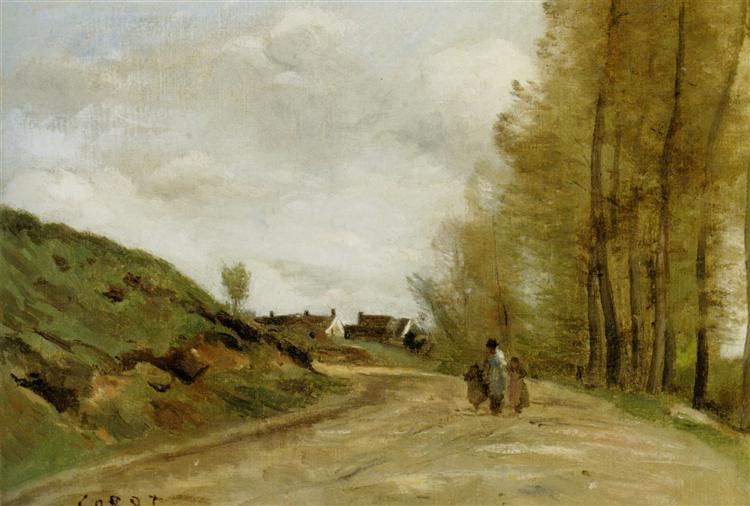Description
Camille Corot, one of the masters of landscape painting in the 19th century, presents us with a work that encapsulates his mastery in the representation of light and natural atmosphere in The Road at Gouvieux. This painting, made in 1865, is a testament to his great ability to capture the essence of nature, as well as his unique vision of the world around him. The work is set in the context of the plein air painting movement, which promoted a more intimate connection between the artist and the landscape. Corot was ahead of many of his contemporaries, seeking not only to depict nature, but also to convey his emotions and personal responses to the environments he portrayed.
In The Path At Gouvieux, the composition is organized around a meandering path that guides the viewer’s gaze through the landscape. The work is dominated by a palette of greens and browns, evoking the freshness of the vegetation and the earthy soil. These colors, along with the use of luminous touches, infuse the scene with a sense of serenity and stillness. Light, one of the hallmarks of Corot’s work, plays a pivotal role, creating a contrast that brings the work to life. The way the light disperses between the trees and highlights the path invites the viewer into a contemplative experience, in which time seems to slow down.
Although there are no human figures in this work, the absence of characters does not take life away from the landscape; on the contrary, it suggests a world in which humans have been present but have withdrawn, leaving nature in its pure state. This is characteristic of Corot's approach, who often explored the relationship between man and nature, and how the latter can exist in a space free from direct human intervention. The path therefore becomes a symbol of exploration, of connection with nature, and perhaps an invitation to introspection.
The texture of the painting is also worth highlighting. Corot’s loose brush technique allows the colours to blend in a way that seems almost ethereal, giving the landscape a sense of depth and three-dimensionality. The way the artist uses layers of paint to create shadows and light suggests a technical mastery that transforms the work into an almost tactile experience. This approach also reveals his admiration for landscape painters of the past, such as Claude Lorrain and Rubens, whose works often captured the majesty of nature and its light.
“The Path at Gouvieux” is not just presented as a simple depiction of a landscape, but acts as a bridge to a greater appreciation of nature in its purest state. The work offers a reflection on the beauty of the natural world and the importance of contemplation. As we move deeper into this landscape, we are reminded of the importance of stopping, observing and appreciating the environment around us – a message that continues to resonate strongly today.
In a broader sense, Corot's work is situated at a transitional moment in art history, both preceding and heralding the arrival of movements such as Impressionism. His focus on light and colour, as well as his dedication to painting landscapes outdoors, laid the groundwork for later artists to explore these themes further. To look at The Road at Gouvieux is not simply to see a landscape; it is to enter into a timeless dialogue between human beings and nature, illustrating the sensitivity of an artist who captured not only what was visible, but also what was essential to the experience of life.
KUADROS ©, a famous painting on your wall.
Hand-made oil painting reproductions, with the quality of professional artists and the distinctive seal of KUADROS ©.
Painting reproduction service with satisfaction guarantee. If you are not completely satisfied with the replica of your painting, we will refund 100% of your money.

